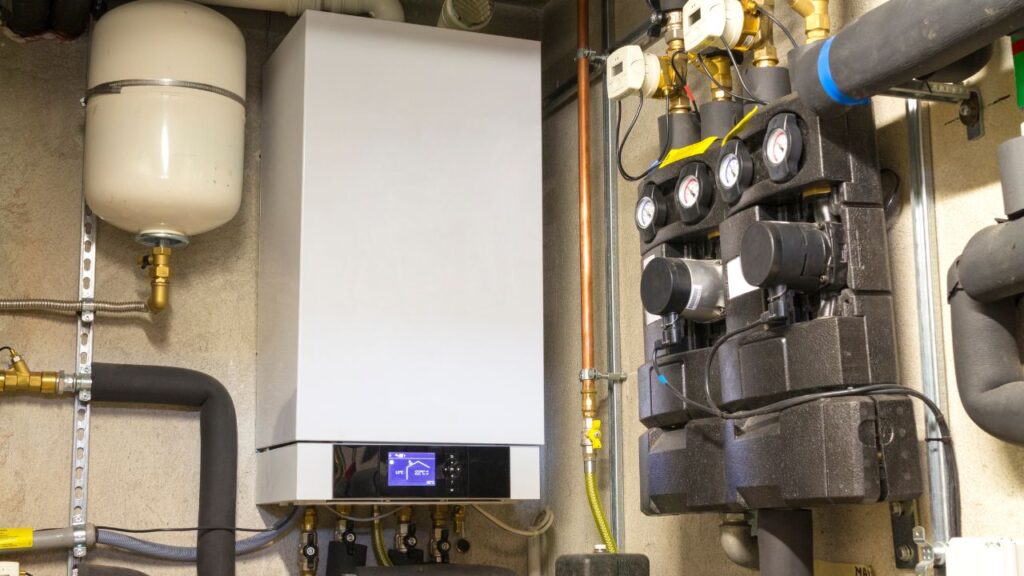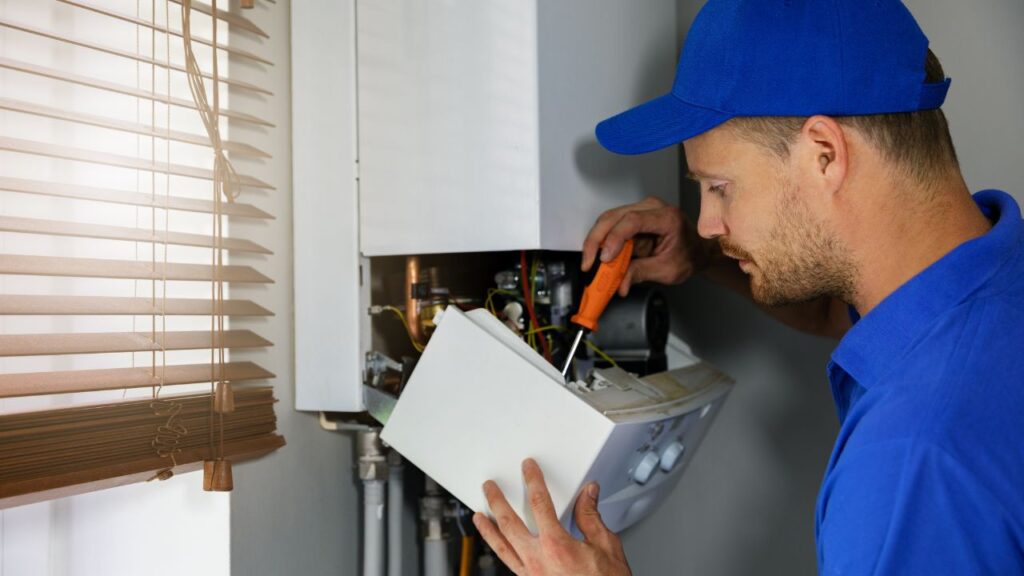Last Updated on November 14, 2025
Are you considering replacing your outdated back boiler with a modern, energy-efficient heating system?
In this expert guide, we’ll delve into the world of back boiler replacement, exploring the benefits, costs, and best practices for removing and upgrading your old heating system.
Contents
- 1 Back Boiler Replacement Overview
- 2 What is a Back Boiler?
- 3 Back Boiler Removal Process
- 4 How Messy is Removing a Back Boiler?
- 5 The Benefits of Replacing Your Back Boiler
- 6 Back Boiler Replacement Cost
- 7 Back Boiler to Combi Conversion
- 8 Back Boiler Fireplace
- 9 Get a Back Boiler Replacement Quote Today
- 10 FAQs
- 11 Final Thoughts
Back Boiler Replacement Overview
- Back boilers are outdated heating systems that have been replaced by modern, more efficient and safer models.
- Removing a back boiler must be done by certified professionals to ensure safety and efficiency standards are met.
- Replacement costs typically range from £3,000 to £5,500+ depending on local regulations and other factors.
What is a Back Boiler?

Back boilers are less energy-efficient compared to modern boilers, such as combi boilers, system boilers, and regular boilers. As a result, replacing your back boiler offers increased energy savings and improved safety.
Back boiler replacement can help you save money on heating costs while providing more reliable heating and hot water. Plus, many heating engineers today lack the expertise to repair back boilers, which can lead to difficult and costly maintenance.
Switching to a modern combi, system, or regular boiler is wise. Modern boilers heat water faster and provide consistent heating. They also reduce carbon emissions, making them better for the environment.
Finally, these new boilers are much easier to install and maintain. The initial investment pays off with long-term savings and improved performance.
Back Boiler Removal Process
Removing a back boiler is a complex process that must be carried out by a certified professional to ensure safety and compliance with regulations.
- A Gas Safe registered engineer will disconnect the pipes connected to the back boiler and remove any unnecessary items and carpets from the vicinity to prevent damage.
- After disconnecting the back boiler, the engineer will remove it.
- They will then reassemble the central heating system if needed, properly connecting all fittings and pipes. With this step, they can guarantee the new unit follows all safety and compliance regulations.
- When a new heating unit is installed, local authorities must be informed. However, a professional back boiler removal company will usually take on this responsibility and follow all the regulations.
- Once the old back boiler is removed and a new unit is installed (if applicable), you’ll receive your Building Regulations Compliance Certificate within a few working days. It is your responsibility to keep it safe.
How Messy is Removing a Back Boiler?
Removing a back boiler can be a messy and intricate process. Here are the steps involved:
- Removing and dismantling components of the fireplace.
- Disconnecting the old back boiler from the central heating system.
- Removing any associated pipes and fittings.
- Capping pipes.
- Potentially redecorating the living space afterwards.
However, hiring a Gas Safe registered engineer can help mitigate the disruption and mess associated with back boiler removal.
These engineers implement several measures to reduce the mess during the removal, including:
- Protecting the surrounding area
- Utilising dust control measures
- Disposing of waste materials appropriately
- Tidying up the work area afterwards
This ensures that your home is left in a clean and orderly state upon completion of the process.
To ensure the safe and efficient disposal of a back boiler, hiring a Gas Safe Registered heating engineer is of utmost importance. Many back boiler components are recyclable, so contacting your local recycling centre or scrap metal yard to determine if they accept old boilers is worthwhile.
The Benefits of Replacing Your Back Boiler
The benefits of back boiler replacement include:
- Enhanced energy efficiency
- Improved safety
- Potential long-term cost savings
These modern boiler replacements are designed to be more energy-efficient and reliable than their back boiler counterparts, providing homeowners with a better heating solution.
Back Boiler Replacement Cost
The cost of replacing a back boiler ranges from £3,000 to £5,500+, depending on the type of new boiler, labour, and additional work required.
These costs cover both the capping of the piping and back boiler removal, as well as the installation of the new boiler system.
Check out our guide on how much a new boiler costs to learn more.
The back boiler replacement cost encompasses the following:
- The installation of a new boiler, which will likely be situated in a new location.
- If a combi boiler is chosen, a hot water cylinder will no longer be necessary and will be removed.
- The primary expenses associated with back boiler replacement are labour costs, the cost of removing the existing back boiler, and the installation costs of the new system.
Before embarking on a back boiler replacement project, consider the following factors:
- Local regulations
- Availability of skilled engineers
- Selection of your boiler and radiators
- The overall impact of the central heating system on boiler efficiency
By taking these factors into account, you can make an informed decision about the best heating solution for your home.

Back Boiler to Combi Conversion
Converting a back boiler to a combi boiler is a popular option due to its increased energy efficiency and space-saving advantages despite the higher initial costs.
A back boiler to combi conversion involves replacing a back boiler with a combi boiler, which is a type of boiler that can supply hot water and central heating from the same unit without requiring an additional water tank.
The benefits of converting to a combi boiler include:
- Annual savings due to increased energy efficiency. Non-condensing back boilers only run at 70% efficiency, whereas condenser boilers can run at up to 90% efficiency
- Hot water tanks can be removed.
- The new boiler can be situated in a kitchen or airing cupboard rather than behind the gas fire like the old back boiler.
The cost of converting a back boiler to a combi boiler is considerably more than the initial costs. According to manufacturers, the cost of replacing a back boiler with a combi boiler ranges from £2,000 to £7,500 and covers both the capping of the piping and back boiler removal.
These boiler replacement costs may vary depending on the type of new boiler and installation fees.
Back Boiler Fireplace
After back boiler removal, the fireplace may require repairs or modifications to accommodate a new heating system or restore its original appearance.
Common fireplace repairs following the removal of a back boiler include:
- Bricking up the revealed cavity in the chimney with concrete bricks or breeze blocks.
- Applying mortar and bonding for an even finish.
- Reconstructing the fireplace, mantle, and a significant portion of the floor beneath the boiler.
The following steps should be taken to restore a fireplace to its original appearance after the removal of a back boiler:
- Remove the back boiler and disconnect any associated pipes and flue.
- Remove any newer bricks or materials covering the original fireplace.
- Insert a lintel at the appropriate height to support the structure above the fireplace opening.
- Restore the original brickwork or stonework of the fireplace.
- Repair or replace any damaged or missing parts of the fireplace, such as mantels or hearths.
It is recommended to consult with a professional fireplace installer or restoration expert for the best results.
Get a Back Boiler Replacement Quote Today
Ready to upgrade from your old back boiler? Eco Happy is here to help. With our extensive experience in boiler replacements, we can help you transition to a modern, energy-efficient system.
Don’t wait any longer. Improve your home’s heating efficiency and save on energy bills. Request a free, no-obligation quote today. Our expert team will guide you through every step, from selecting the right boiler to professional installation and aftercare.
FAQs
Are back boilers now illegal?
Given the potential risks, back boilers have been illegal to install since 2005 and should not be fitted. It’s not illegal to have a back boiler that was installed before this law was implemented.
However, due to the poor efficiency and danger that back boilers present, back boiler replacements have become more and more popular among homeowners.
Is a back boiler a good idea?
No, it is not a good idea to use a back boiler.
Back boilers are incredibly inefficient when compared to modern combi boilers, with energy efficiency of only 70%, far below the government-mandated 86% minimum.
Additionally, a significant portion of the money you pay for heating is wasted due to back boilers relying on warmth from the fireplace to warm the water inside. For these reasons,.
What is a Baxi Bermuda Back Boiler?
When back boiler heating systems were legal and more common, the Baxi Bermuda back boiler was among the most popular choices. Compared to other boiler costs, the Baxi Bermuda was a more costly and durable option.
Despite this back boiler being one of the better choices to save money for homeowners, it still wasn’t an energy-efficient boiler compared to more modern systems. When you replace your back boiler and opt for a combi boiler, you gain a much more efficient heating system.
How much does a back boiler cost?
The cost to remove a back boiler alone ranges from £900 to £1,500, while a complete replacement of the back boiler and central heating system will range from £3,000 to £5,500+.
Are there any grants available for back boiler removal?
Unfortunately, there are no grants specifically for back boiler removal. However, homeowners may be eligible for a grant to upgrade their heating system under the Boiler Upgrade Scheme.
What is the alternative to replacing a back boiler with another back boiler?
A suitable alternative to replacing a back boiler is installing a new gas boiler, offering a modern and efficient option.
Final Thoughts
Replacing a back boiler with a modern, energy-efficient heating system is an excellent investment for homeowners seeking improved energy efficiency, safety, and long-term cost savings.
By upgrading your outdated back boiler, you can enjoy a cosy, cost-effective home and rest easy knowing that your heating system is working at its optimal efficiency.





Tom Allen
Solar Expert